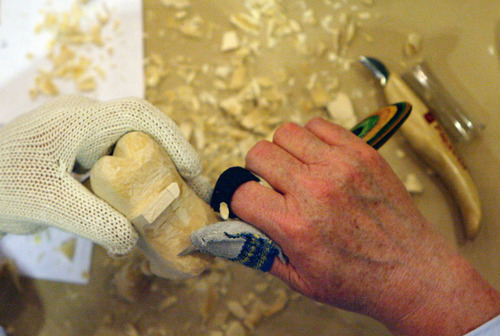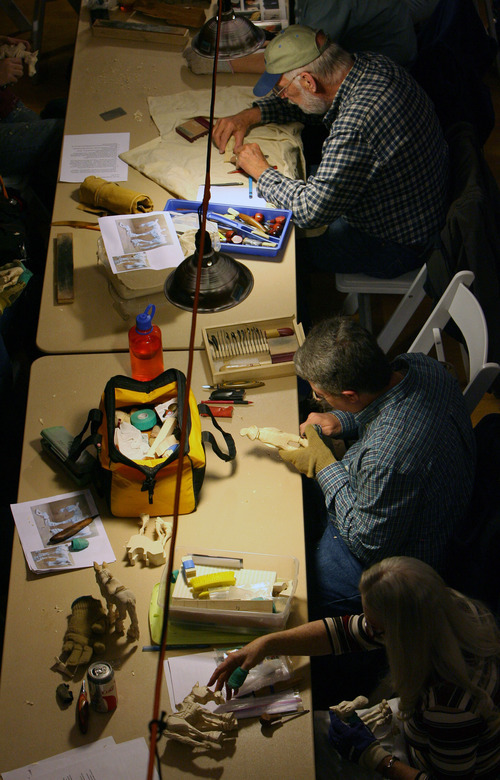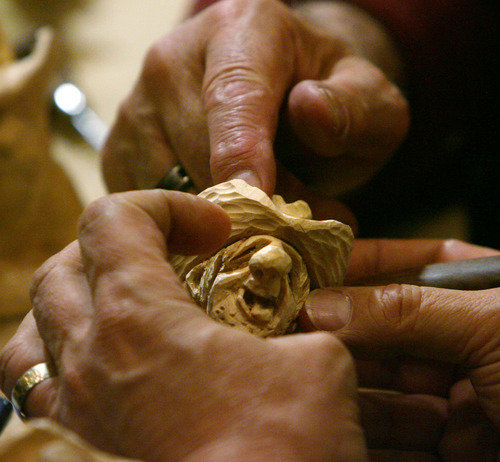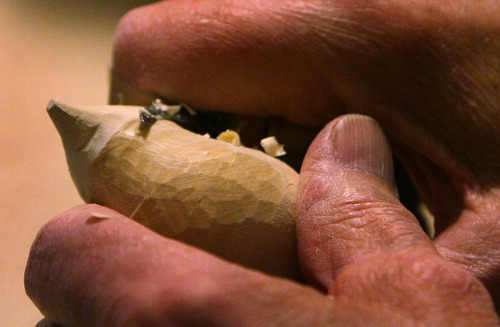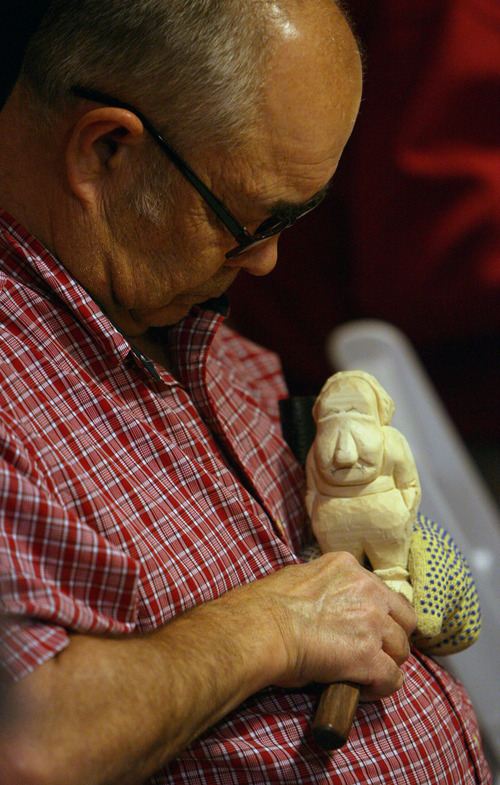This is an archived article that was published on sltrib.com in 2012, and information in the article may be outdated. It is provided only for personal research purposes and may not be reprinted.
Murray • The first time someone put a piece of wood in Dick Gilbert's hands, he wasn't sure what it would look like when he started — or finished — carving.
The last time he took a knife to wood, he knew exactly what he wanted: a 7-foot totem pole based on the work of the indigenous tribes of the Pacific Northwest.
In between, Gilbert has worked on everything from finely detailed grizzly bears to silly caricatures to leprechauns toasting each other over a pot of gold.
"I took a class on learning to carve. [The teacher] handed me a block of wood and said, 'Trust me. Cut here, cut here, cut here,' and an hour later there was a face looking at me," said Gilbert during a weekly gathering of the Great Salt Lake Woodcarvers Club at Wheeler Historic Farm.
Gilbert has spent so much time carving since he took up the passion four years ago that his current knife, which started with a 3-inch blade, is down to an inch long.
"If you drop it and break the tip, you have to reshape it," he said. "I really don't know how many carvings I've done. It must be in the hundreds."
The teacher from Gilbert's first class is Marilyn Ure. Widely recognized as one of the best carvers in Utah — perhaps one of the best in the country — Ure teaches classes on carving. On one recent night, her students were nearing completion on a 8- to 10-inch horse with a saddle. Other club members were working to finish pieces in time for entry in the 20th Annual Woodcarving Show March 23-24 at Wheeler Farm.
Ure remembers the desire to make something of a wood block. She first felt it about six years ago.
"I saw a little moose or something and I just thought to myself 'I must do that,' " Ure said while simultaneously gazing around the room to check out other carvers, answering a question and whittling away at a piece of basswood.
When she isn't teaching carving, Ure is doing it herself — all the time.
"I have wood chips all over my house," she said. "It is a whittling-Boy-Scout-gone-bad type of thing. Especially when I'm watching television. The more action there is, the faster I go. It is kind of crazy."
The Great Salt Lake Woodcarvers Club meets every Tuesday at 6 p.m. in the Activity Barn at Wheeler Farm. More than a dozen and often as many as 20 carvers — participants do not need to be members — meet each week. They include chippers, relief cutters, barkers and chainsaw carvers. Then there are gougers, like club president George Jay, who has a different word for his style.
"I'm a chunker, but Marilyn told me I'm creative. I'm not sure if that is good or bad," Jay said.
Jay has served as president of the club for three years and first got into carving 15 years ago while watching a good friend cutting wood into art. Long retired from his job as a miner, Jay enjoys sharing his work with family, friends and, sometimes, complete strangers.
That seems typical of the 65 club members who range from teenagers to folks in their 80s.
"Ninety percent of us just do it for fun," Jay said. "Even those who do it and make some money are really just doing it for fun."
Ure once carved 200 caricatures based on mug shots to make place cards of wedding guests' likenesses.
"It was fun, but I had such a short time to get it done. It could have been fabulous," said Ure. "I don't know if it helped them figure out where they were to sit or not because I didn't get to watch them."
Like Jay, Ure enjoys the reactions she gets from sharing her work with others.
"I love giving them away. The best thing is to be sitting around carving something and to have some kid walk by and to hand it to them. They are so excited when they realize they get to take it home."
Carvers have a way of producing scars unlike other hobbyists.
"Nonmembers have to sign a waiver when they show up to carve with us," Jay said. "Once you sign that release, the blood is yours."
Carvers sport all kinds of contraptions to avoid cutting themselves while working. Ure wears gloves and has a special splintlike device for her thumb.
"These are Kevlar gloves with leather," she said, holding her hands up. "The Kevlar slows it down and the leather slows it down, but nothing stops a sharp knife blade."
Ure sliced open her palm once, just once, when a carving she was working on broke. She wasn't wearing a glove.
"I was lucky, I didn't get any tendons," she said. "We have all learned the hard way to always have safety equipment on."
Ure doesn't enter the annual carving contest. As a judge, she doesn't like the implications of having her own work submitted in the show.
Jay said the competition has averaged 340 pieces the past seven years, including carvings from Florida, Colorado, Wyoming, Idaho, Nevada and even Brazil.
Carvers from across the world enter the Great Salt Lake Woodcarvers show by shipping their pieces in time for display. Once the judging and the show are over, the entries are sent back to the owners, who pay for the shipping.
The show is a way for carvers like Gilbert to show off impressive pieces such as the totem pole he carved out of a felled aspen tree. The 7-foot pole depicting an eagle, a bear holding a fish, a frog and a beaver will be placed in Gilbert's backyard after the show so he can enjoy his work for years to come.
20th annual Woodcarving Show
The Great Salt Lake Woodcarvers Club is holding its 20th annual Carving Show March 23-24 in the Machinery Barn at Wheeler Historic Farm, 6351 S. 900 East, Murray. The show runs from noon to 8 p.m. on the 23rd and from 9 a.m. to 5 p.m. on the 24th. General admission is $5, $3 for seniors and $2 for kids under 12. Visit http://www.GreatSaltLakeWoodcarvers.com for more information.


